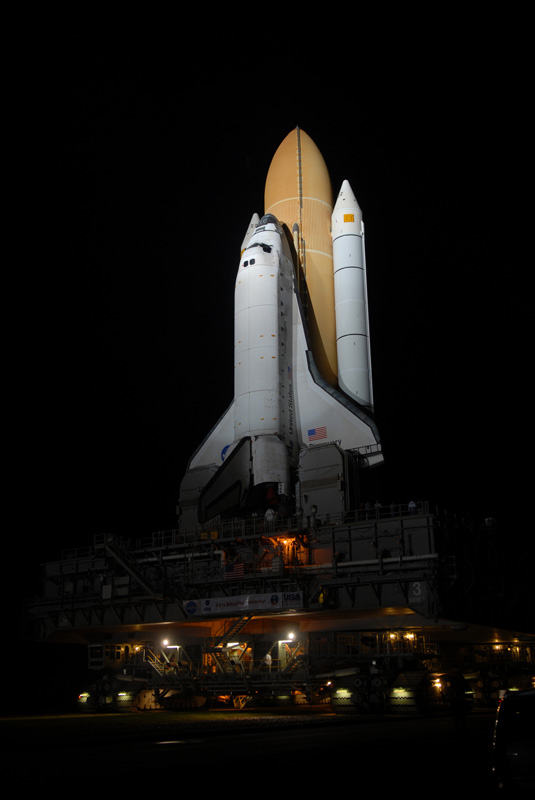NASA Finds Fuel Leak on Space Shuttle Discovery

The space shuttle Discovery has developed a small fuelleak while on the launch pad, with NASA engineers working to make repairs intime for the spacecraft's final launch on Nov. 1.
The leak was discovered in an aft compartment on thespace shuttle where two propellant lines converge to feed Discovery's two orbitalmaneuvering system engines. It must be repaired soon if Discovery is to makeits scheduledlaunch from NASA's Kennedy Space Center in Cape Canaveral, Fla.
Engineers spotted the leak when they noticed that some of Discovery's insulating blankets covering a sealin the area were damp with monomethyl hydrazine, one of two chemicalsused to ignite the engines located on either side of shuttle's tail, NASA officials said. [Photos:Discovery's Launch Pad Trip]
"It?s clearly a very toxic chemical, so a lot ofprecautions have to be taken even with a very small leak like this," NASAspokesman Allard Beutel told SPACE.com.
Beutel said shuttle engineers plan to tighten six bolts aroundthe flange seal to stop the leak. If that doesn't solve the problem,technicians wearing bulky hazmat suits can try to replace two seals in thesystem.
"The processing schedule could allow the two sealsto be replaced without delaying Discovery's targeted launch on Nov. 1,"NASA officials said in an update.
Beutel said NASA currently has four days of padding inits schedule to repair Discoveryin time for its upcoming launch.
Get the Space.com Newsletter
Breaking space news, the latest updates on rocket launches, skywatching events and more!
Discovery's twin orbital maneuvering system engines arevital for the shuttle's mission. They are used for major course correctionswhile the shuttle is in orbit, as well as to begin the descent back to Earth.
"Specifically, we use these engines to drop out oforbit at the end of the mission," Beutel said.
Discovery also has three main engines, located below its orbital maneuvering system pods, which help launch the shuttle into orbit.
Discovery is poised to launch on an 11-day mission todeliver a storage room and humanoid robot to the InternationalSpace Station. The mission will be the last spaceflight for Discovery ?NASA's oldest shuttle ? and is one of the two missions scheduled before NASAretires its shuttle fleet next year.
The shuttle Endeavour is slated to fly the last scheduledmission in early 2011. A third,extra shuttle mission has been approved by Congress and President Obama andis due to be reviewed by congressional appropriators later this year.
- Gallery: Shuttle Discovery's Last Launch Pad Trip
- POLL: What Do You Think About NASA's New Direction?
- Last Crew of Space Shuttle Discovery Practices Launch Escape
Join our Space Forums to keep talking space on the latest missions, night sky and more! And if you have a news tip, correction or comment, let us know at: community@space.com.

Tariq is the Editor-in-Chief of Space.com and joined the team in 2001, first as an intern and staff writer, and later as an editor. He covers human spaceflight, exploration and space science, as well as skywatching and entertainment. He became Space.com's Managing Editor in 2009 and Editor-in-Chief in 2019. Before joining Space.com, Tariq was a staff reporter for The Los Angeles Times covering education and city beats in La Habra, Fullerton and Huntington Beach. In October 2022, Tariq received the Harry Kolcum Award for excellence in space reporting from the National Space Club Florida Committee. He is also an Eagle Scout (yes, he has the Space Exploration merit badge) and went to Space Camp four times as a kid and a fifth time as an adult. He has journalism degrees from the University of Southern California and New York University. You can find Tariq at Space.com and as the co-host to the This Week In Space podcast with space historian Rod Pyle on the TWiT network. To see his latest project, you can follow Tariq on Twitter @tariqjmalik.









